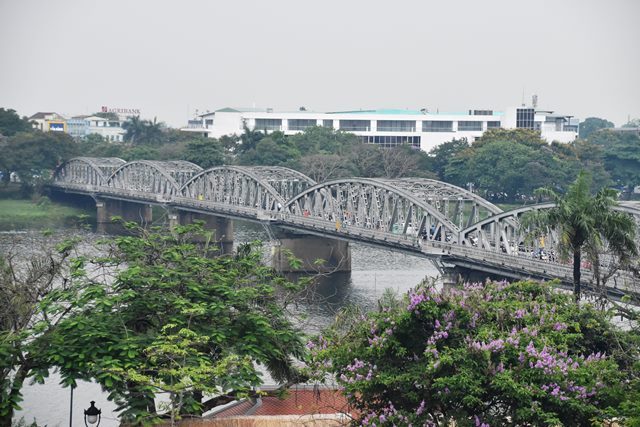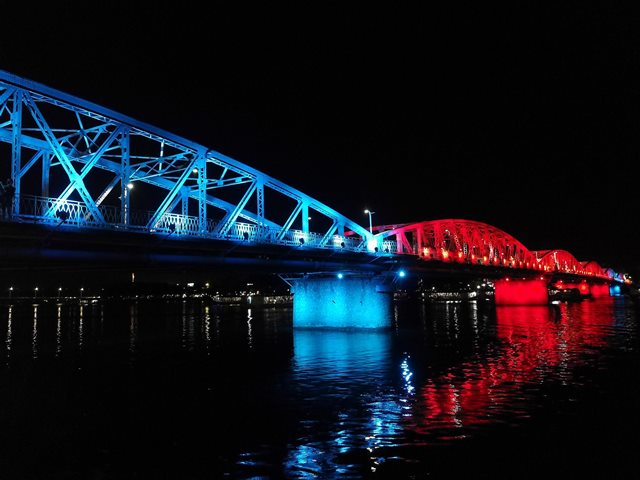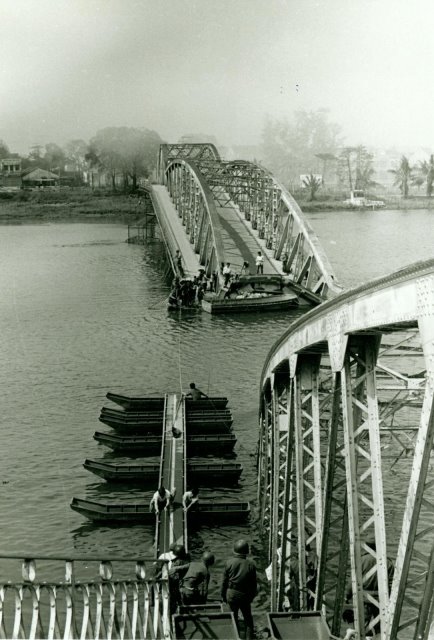We Recommend:
Bach Steel - Experts at historic truss bridge restoration.
BridgeHunter.com Phase 1 is released to the public! - Visit Now
Cầu Trường Tiền (Truong Tien Bridge)
Cầu Tràng Tiền (Trang Tien Bridge)

Primary Photographer(s): Nathan Holth
Bridge Documented: April 14, 2019
Hue (Huế): Thua Thien Hue Province (Thừa Thiên-Huế): Vietnam (Việt Nam)
1899 By Builder/Contractor: Unknown and Engineer/Design: Gustave Eiffel
Not Available or Not Applicable
220.0 Feet (67.1 Meters)
1,320.8 Feet (402.6 Meters)
Not Available
6 Main Span(s)
Not Applicable

View Information About HSR Ratings
Bridge Documentation
One of the longest surviving historic bridges in the country is this multi-span bowstring truss with a long, complicated history. It was reportedly designed by the famous French engineer Gustave Eiffel who designed the Eiffel Tower in Paris, France.
There are three events that have badly damaged this bridge. The first was in 1904 when a typhoon damaged the bridge. One photo appears to show about four spans collapsed. One source claimed repairs to whatever damage was caused did not take place until 1937. However, a 1906 and 1909 postcard shows the whole bridge standing so the damage appears to have been repaired quickly. Since this occured only a few years after the bridge was built the new spans probably took the same form and design details as the original spans.
Some of the northern spans of the bridge were destroyed in 1946 during fighting between independence forces and the French. The destroyed spans were apparantly rebuilt after this time. These rebuilt spans were similar to the original spans but lacked v-lacing on built-up members.
In 1968, two central spans were destroyed in the Battle of Hue.
As seen today, the northern four spans of the bridge are clearly newer than the southern two spans. The southern two spans appear to be the only spans that date to 1899. These spans contain lighter members and there is v-lacing used on the built-up beams of the bridge. The northern four spans are a heavier design and use battens instead of v-lacing for the built-up members. Otherwise however the appearance of both original spans and the repalcement spans are very similar, and all feature riveted construction. It is not known if all four northern spans date to after the 1968 destruction, or if one or more of the rebuilt spans from after 1946 survived.
Due to the differing design of the bridge spans, HistoricBridges.org features a large set of detail photos divided into the northern and southern spans.

Above: Bridge at night with decorative lighting.
Above: Photo showing spans collapsed in 1904 from a typhoon.
Above: Bridge in 1906.
Above: Bridge in 1909.
Above: Destruction of the bridge in 1946
Above: Destruction of the bridge in 1968. Note that the collapsed span in the foreground has v-lacing on its members and thus may be an original span. The other collapsed span in the distance lacks v-lacing and thus appears to be one of the rebuilt spans from the 1946 destruction.
Refugees fleeing over the collapsed bridge in 1968.
![]()
Photo Galleries and Videos: Cầu Trường Tiền (Truong Tien Bridge)
Bridge Photo-Documentation
Original / Full Size PhotosA collection of overview and detail photos. This gallery offers photos in the highest available resolution and file size in a touch-friendly popup viewer.
Alternatively, Browse Without Using Viewer
![]()
Bridge Photo-Documentation
Mobile Optimized PhotosA collection of overview and detail photos. This gallery features data-friendly, fast-loading photos in a touch-friendly popup viewer.
Alternatively, Browse Without Using Viewer
![]()
Light Show On Bridge
Full Motion VideoNote: The downloadable high quality version of this video (available on the video page) is well worth the download since it offers excellent 1080 HD detail and is vastly more impressive than the compressed streaming video. Streaming video of the bridge. Also includes a higher quality downloadable video for greater clarity or offline viewing.
![]()
Maps and Links: Cầu Trường Tiền (Truong Tien Bridge)
Coordinates (Latitude, Longitude):
Search For Additional Bridge Listings:
Additional Maps:
Google Streetview (If Available)
GeoHack (Additional Links and Coordinates)
Apple Maps (Via DuckDuckGo Search)
Apple Maps (Apple devices only)
Android: Open Location In Your Map or GPS App
Flickr Gallery (Find Nearby Photos)
Wikimedia Commons (Find Nearby Photos)
Directions Via Sygic For Android
Directions Via Sygic For iOS and Android Dolphin Browser








